A Midsummer Night's Dream
A Dream Dream Celebrates a Waking Dream
Cincinnati Shakespeare Company, Otto M. Budig Theater, Cincinnati, Ohio
Saturday, September 9, 2017, C–107&108 (center, first tier)
Directed by Brian Isaac Phillips
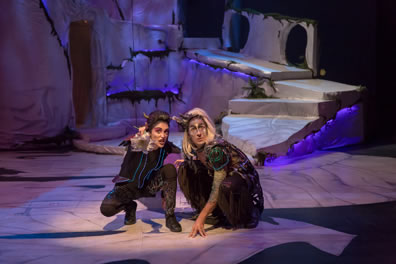
Puck (Sara Clark) conspires with Oberon (Giles Davies) in the Cincinnati Shakespeare Company's production of William Shakespeare's A Midsummer Night's Dream, which inaugurated the company's new Otto M. Budig Theater. Photo by Mikki Schaffner Photography, Cincinnati Shakespeare Company.
I had nothing with which to dab the tears from my eyes. They streamed down my cheeks to my beard. Crying at plays is something I do on occasion: I even use the phenomenon as a measure of my appreciation for the product, such as noting when the tears first form (or if they never form) when watching William Shakespeare's King Lear. Here I'm watching Shakespeare's A Midsummer Night's Dream, and as Philostrate reports when he watched the rude mechanicals rehearse Pyramus and Thisbe, seeing Bottom and company present their "most lamentable comedy" before Duke Theseus and the other newlywed nobles has sometimes "Made mine eyes water; but more merry tears the passion of loud laughter never shed." That comes in the final act of A Midsummer Night's Dream.
Um, but we're only in Act III, Scene 1, and I'm bawling from the accumulative effects of laughing since even before the play's first line was spoken. And what starts up the salt fountains isn't even Shakespearean. "Butt Masters!" first put me into uncontrollable stitches. Then, after Puck transforms Bottom into a glam-rock donkey and scatters the other mechanicals in a chaotic fright, Snug (Billy Chace) runs, yelling the whole way, across the stage, up the aisles through the audience, around the back of the theater, down the other aisle through the audience, and around the front of the thrust stage to one side where he finally stops, panting out of breath, and says, "This theater is a lot bigger than the old one." It brings the house down.
You had to have been there. For, yes, this is a brand new house, the Otto M. Budig Theater, that the Cincinnati Shakespeare Company (CSC) is debuting with this production of A Midsummer Night's Dream helmed by the company's producing artistic director, Brian Isaac Phillips. It is a fabulous new house, too, and as we settled into our seats before the show, I was prepared to focus my rave review on the company's new digs. Then, the company itself, with its long-tenured acting corps—the cast members average eight years with CSC, ranging from an actress in her debut season to two actors in their 18th year—launches into rave-up hilarity in A Midsummer Night's Dream that shows off all that their new play space has to offer. So, my review of the theater is in an addendum below.
A Midsummer Night's Dream is such a natural choice for opening a new Shakespeare theater that this is the third such debut we've seen in four years (Theatre for a New Audience in Brooklyn, New York, in 2013 and Chesapeake Shakespeare Company in Baltimore, Maryland, in 2014; both productions are reviewed on Shakespeareances.com). It's a play about theater and about magic, and Shakespeare blends the two thematically (he does the same with The Tempest, the choice for Shakespeare & Company's inauguration of its new Roman Garden Theater last month, also reviewed on this website). Phillips, in his program notes, also touches on the play's theme of transformation. "The Cincinnati Shakespeare Company has transformed," he writes. "Thanks to the hard work, love, and support from so many artists, patrons, and community leaders, we have transformed into the world-class institution we dreamed we could be. It's a transformation born out of love, so I think a play about the power of love to transform is the best way to celebrate."
Celebrating is what this Midsummer Night's Dream is really about, in tone and metatheater aspects as a showcase for the new space. Though the 233-seat auditorium is intimate, the stage itself is spacious. The play’s first two scenes are played on the thrust portion of the stage with silver leaves painted on the floor, white boulders covered in moss, and Parthenon-like columns projected on a floor-to-ceiling curtain at the back. When the play moves to the Athenian woods, that curtain slips away to reveal Scenic Designer Shannon Moore's three-story set of white rock verandas, caves, and cutouts resembling owl or winking eyes (Oberon spies on Titania through one of these holes).
Phillips uses the entire theater for his stage (much to Snug's chagrin): Oberon roams in the second tier seating as he converses with Puck on the stage, and fairies sit amid the audience in the first tier and perch on the aisle railings—and hover in the air. This production shows off the new theater's flying capabilities, including several incidents of Puck (CSC Associate Artistic Director Sara Clark) taking flight, the third time shouting, "This is still awesome!" Phillips doesn't try to hide the mechanism of flight: Oberon even seems to use a spell to have the line lowered that he then clips to a kneeling Puck's back, going through all proper safety protocol in the same graceful manner as he would if he were, oh, administering a love potion from a flower.
Clocking in at two hours and 20 minutes with an intermission, the production generally sticks to Shakespeare’s script with few cuts, and Costume Designer Amanda McGee dresses the Athenian nobles in classic Greek skirts (men) and gowns (women). However, the Shakespearean aesthete comes with 21st century adornment. McGee dresses the rude mechanicals of Athens in denim Elizabethan knee breeches and Timberland boots, and the cast peppers the play with modern idiomatic expressions and gestures. Francis Flute (Jeremy Dubin in a tour de force performance of a macho man embarrassedly playing Thisbe) makes an exploding head gesture in response to some Bottom brilliance. When "Phoebe" Quince (Kelly Mengelkoch) begins one of her instructions with the interjection, "But, masters" (textual), Flute and Snug simultaneously shout "Butt Masters!" and high-five each other (such reinterpretations by the two recur twice more). The whole group forms a hand-in-center circle shouting "Adieu" like a team cheer before a game: "aaaaaa-DIEU!"
A metatheater moment opens the proceedings. You take your seats to the soundtrack of delicate electro-Muzak playing vaguely recognizable tunes: listen hard and you will discern David Bowie’s "Major Tom," Blue Oyster Cult’s "(Don’t Fear) The Reaper," and Elton John’s "Your Song." Might make you think of fairy music—until you see the fairies in this production (McGee dresses the fairies as heavy metal glam rockers, a cross of Kiss and Queen). A single ghost light stands on the stage, and as the house lights go down, a trumpet fanfare sounds, and Philostrate (Sylvester Little Jr.) walks on stage, looks around, smiles proudly at the audience, and then removes the light.
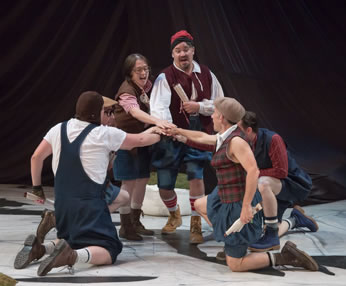
The rude mechanicals gather for an "aaaaaa-DIEU!" cheer in Cincinnati Shakespeare Company's production of Shakespeare's A Midsummer Night's Dream. From left, Snug (Billy Chace), Snout (Paul Riopelle), Quince (Kelly Mengelkoch), Bottom (Matthew Lewis Johnson), Starveling (Justin McCombs), and Flute (Jeremy Dubin). Below, Lysander (Crystian Wiltshire, left) listens impatiently to Hermia (Courtney Lucien) while, in the background, Demetrius (Kyle Brumley) makes love to Helena (Caitlin McWethy). Bottom, the cast does its final curtain call to the rocking tunes of the fairy band, "The Philomels." Photos by Mikki Schaffner Photograph, Cincinnati Shakespeare Company.
What happens next establishes Phillips' intent to keep this Midsummer Night's Dream firmly in the genre of comedy: Theseus (Darnell Pierre Benjamin) and Hippolyta (Maggie Lou Rader) come on stage engaged in an intense sword fight and begin speaking their opening lines even as they keep fighting. Swordplay is obviously foreplay for the betrothed Duke of Athens and warrior queen of the Amazons.
The comedy is genial, as exemplified by Egeus (Barry Mulholland) reconciling with his daughter, Hermia, after Theseus overrules his edict that she marry Demetrius (Kyle Brumley) instead of Lysander. He even enters with the newly wed Hermia and Lysander in the final act.
The comedy is extratextual. In the opening scene, Hermia (Courtney Lucien) reveals to Helena (Caitlin McWethy) her secret engagement to Lysander (Crystian Wiltshire) causing Helena to erupt in a screaming frenzy of delight. "I know!" Hermia screams back. In the final scene, Snug begins his speech as the Lion with, “You, ladies, you, whose gentle hearts do fear the smallest monstrous mouse that creeps on floor,” and Chance then interjects, “Not you, Hippolyta,” and mimes her shooting an arrow, which Rader's Hippolyta pretends to catch.
The comedy also involves ultraliteral interpretations of the text. Tom Snout (Paul Riopelle) actually takes an onion and a garlic out of his fanny pack and is about to eat them when Bottom (Matthew Lewis Johnson) shouts, “Eat no onions nor garlic, for we are to utter sweet breath.”
And the comedy is bawdily raucous. Lysander, trying to convince Hermia to let him sleep by her side after they get lost in the woods, "riddles very prettily" about two bosoms. No riddle, really: Wiltshire's Lysander is referring to her breasts. This becomes a running joke riding more textual references and beyond: the suddenly Helena-besotted Lysander tells her that "Nature shows art, that through thy bosom makes me see thy heart," and, after he's departed in chase of Helena, Hermia awakens from a nightmare calling out for Lysander to "pluck this crawling serpent from my breast!" When Hermia finally catches up with Lysander she jumps into his arms, smothering his face with her breasts. "Acckkk! Bosoms!" Wiltshire says in disgust.
The only point on which I was uncomfortable with the textual or comic license was Justin McCombs playing Robin Starveling with a stutter. I do not approve of any disability being used as a vehicle for comedy, but I rather liked the moment when Bottom returns from his sojourn as an ass and announces, "Masters, I am to discourse wonders." In a performance of absorbingly adorable self-importance, Johnson's drama queen Bottom pauses, waiting for one of his fellows to beg him to continue, whereupon Starveling steps forward to do just that but can't get beyond several "W" sounds before Bottom, grown impatient, cuts him off with "but ask me not what," and Starveling shrugs and backs away. Starveling plays Moonshine in Pyramus and Thisbe, victim of the worst teasing from the nobles. But in this production, after the teasing when Lysander says, "Proceed, Moon" he does so as a chant with clapping and gets the audience to join in, whereupon Starveling triumphantly gets his lines out without stuttering.
Titania (Miranda McGee, wearing a cream gown with huge fur shoulders and cuffs), has magic powerful enough to neutralize Oberon (Gile Davies in tassled pants and a cloak of woven straps). Her superiority in magic might be why he needs to trick her into giving him her Indian boy changeling (a puppet in this production). However, her speech describing her relationship with the boy's mother is so sweet that Oberon’s subsequently infecting her with a love potion that makes her fall in love "when some vile thing is near" comes off as excessively selfish and mean. When she does fall in love with that vile thing, Bottom with his ass's head and an extraordinarily long tail, McGee emits a high-pitched squeal of thrill every time she merely touches him. Clark's Puck, in recounting to Oberon how Titania came to be enamored of an ass, works Starveling's stuttering and Titania's squealing into her tornado-delivered speech and earns applause from the audience when she concludes, whereupon she curtsies and high-fives a woman in the audience.
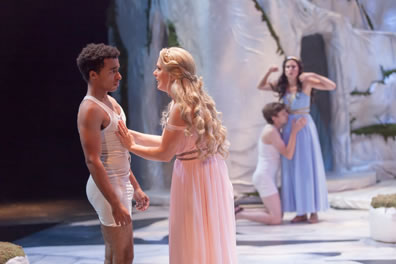 When a production of A Midsummer Night's Dream is firing on all cylinders, as this one does, the piston deserving the most comment is the lovers, the weakest element of Shakespeare's Athenian landscape. Outstanding performances combine with Phillips' clever blocking to put these lovers on par with the rude mechanicals and the fairies. McWethy is one of the most inventive Helenas I've ever seen. Dressed in a blue and white classic gown that recalls Disney's Snow White, her Helena is an airhead to the extreme, talking with a modern girl dialect lacking only excessive use of "like" and "you know" to resemble any number of 20-somethings we hear out and about. Yet, McWethy uses Shakespeare's verse to inform all her stupid girl readings (and she's capable of turning seriously wise on occasion). Her deciding to tell Demetrius about Hermia's stealing away with Lysander comes off simply as the dumb idea it is. Her portraying herself as Demetrius's spaniel is just so Helena, too; when Demetrius tells her to "Stay, on thy peril: I alone will go," his pause after the first word inspires her to put up her paws and smile with her tongue out like an expectant dog staying on command. No wonder Demetrius grew weary of her after initially courting her before the play.
When a production of A Midsummer Night's Dream is firing on all cylinders, as this one does, the piston deserving the most comment is the lovers, the weakest element of Shakespeare's Athenian landscape. Outstanding performances combine with Phillips' clever blocking to put these lovers on par with the rude mechanicals and the fairies. McWethy is one of the most inventive Helenas I've ever seen. Dressed in a blue and white classic gown that recalls Disney's Snow White, her Helena is an airhead to the extreme, talking with a modern girl dialect lacking only excessive use of "like" and "you know" to resemble any number of 20-somethings we hear out and about. Yet, McWethy uses Shakespeare's verse to inform all her stupid girl readings (and she's capable of turning seriously wise on occasion). Her deciding to tell Demetrius about Hermia's stealing away with Lysander comes off simply as the dumb idea it is. Her portraying herself as Demetrius's spaniel is just so Helena, too; when Demetrius tells her to "Stay, on thy peril: I alone will go," his pause after the first word inspires her to put up her paws and smile with her tongue out like an expectant dog staying on command. No wonder Demetrius grew weary of her after initially courting her before the play.
The play’s centerpiece scene, the brawling lovers, is tremendous fun, even with the now-obligatory undressing, which actually begins in the earlier scene when Hermia decrees that Lysander sleep apart from her. Walking to the other side of the stage, he removes his Athenian skirt to reveal his tight union suit underwear (and, boy, does that make Hermia hot, but she's already pushed him away). When the drugged Demetrius and Lysander court Helena, Demetrius realizes he's at a disadvantage still wearing his skirt, so he disrobes to reveal he, too, is wearing a union suit. As Helena babbles on at the front of the stage about her childhood memories with Hermia, behind the two women the two underwear-clad men pose, do pushups, and unsuccessfully try to pick up the boulders, attempting to attract Helena's attention. Some actresses may not appreciate being upstaged during their longest speech of the play, but McWethy, serving the ensemble comedy of the moment, turns this seemingly superfluous passage into yet another momentum-building engine for the scene. Soon enough, Hermia determines that Helena is solely responsible for Lysander's sudden switch in affection, and she removes her own gown as she prepares to fight Helena; and in that fight, Helena's gown comes off, leaving both women in white slips. Their fight is staged as a professional wrestling bout, complete with posing and audience prompting. But Lucien shows herself to be a stage combat pro as her Hermia accomplishes a flying, split-legs kick that takes out both Lysander and Demetrius simultaneously. She also lifts one of the boulders (it's obviously heavy for her, but she's obviously stronger than the well-sculpted guys) and throws it at Helena across the stage.
This is one of the most physical stagings of A Midsummer Night's Dream from flying fairies and fighting ladies to clumsy amateur thespians staging Pyramus and Thisbe. Then comes Bottom's death scene as Pyramus. Johnson employs a constrained physicality in his portrayal of Bottom in the manner of a mime artist, and with this skill he draws out Pyramus's death longer than any Pyramus has ever suffered before with a twist-ending punchline so stupid yet so Bottom. Johnson's Bottom's Pyramus already has stabbed himself in his right, no, left pap. Zombie-like, he rises and, with each shout of "DIE!" goes to each of the couples and, in turn, pretends to tear off his head for Lysander and Hermia, pretends to rip out his heart, tear it in two, and drop each half on Theseus and Hippolyta, and pretends to slit his wrists and let the blood gush on Demetrius and Helena. He then gets an idea and mimes taking a long rope and forming a noose, which he puts around his neck. Looking around for something to hang the rope to, he comes up with another idea: he sets about growing a tree. He plants it, waters it, and time goes by as evidenced by his indicating how high the tree has grown since his last watering. Finally, it's tall enough, and the limbs strong enough, that he can carry out his intentions, though by now he is obviously an old man. He tries throwing the rope over a limb and fails. He tries again and fails. He tries again and dies of a heart attack. It also sets up a greater context for the next joke when Dubin's Flute comes on to play Thisbe's death and has to be physically restrained from taking on Hippolyta, Amazon queen or not, when she says, "I hope she will be brief."
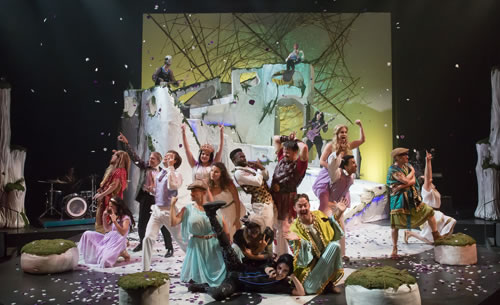 At the real play's end, Puck strolls out on stage alone to deliver the epilogue, notably it is Clark the actress, not as the fairy, who speaks it, the final moment when theater art bends into theater reality—the twain of two forms of magic. Not that the celebratory mood has ended, for after the formal curtain call, four fairies form a power rock band, "The Philomels" (keyboards, guitar, bass guitar, and trap set) and play a song for the cast to dance to and a second number for the audience to exit to.
At the real play's end, Puck strolls out on stage alone to deliver the epilogue, notably it is Clark the actress, not as the fairy, who speaks it, the final moment when theater art bends into theater reality—the twain of two forms of magic. Not that the celebratory mood has ended, for after the formal curtain call, four fairies form a power rock band, "The Philomels" (keyboards, guitar, bass guitar, and trap set) and play a song for the cast to dance to and a second number for the audience to exit to.
As we leave the theater, we notice three dates on the new building’s cornerstone: 1564, 1993, 2017 (Shakespeare’s birth, CSC’s launch, the Budig Theater’s opening). With this theater, with this company, and with this playwright, the magic and its celebration is ongoing.
Eric Minton
September 15, 2017
Inspired Inspiration
The $14 million Otto M. Budig Theater—the cost covered by pledges through a successful capital improvement campaign that also has left the company with a $3 million endowment fund—takes inspiration from various famous theaters through time. The entrance has a peaked roof, representing the tent that housed the original Shakespeare festival in Stratford-upon-Avon, England. Shakespeare's own Globe Theater is represented in the comfortably spacious lobby: the large lobby bar is made of reclaimed barn wood, and the high ceiling painted blue with dangling lights represents the sky as seen through the Globe's open roof. The rest of the decor is concrete in a nod to the National Theatre in London while corrugated steel walls evoke theater curtains. The flexible-thrust auditorium was inspired by the Royal Shakespeare Company's Swan Theatre in Stratford.
Tributes to Shakespeare are worked into the structure. At one end of the lobby is a two-tiered seating platform and steps to the theater's second tier. The titles from Shakespeare's canon decorate the risers: the four collaborated plays (Timon of Athens, Pericles, Henry VIII, and The Two Noble Kinsmen) occupy one set of steps, the history plays are etched into the two-tiered platform, and other titles take you upstairs. You'll find four Shakespeare quotes at key locations:
- "I like this place and willing could waste my time in it," from As You Like It on the floor at the main entrance;
- "Good company, good wine, good welcome can make good people," from Henry VIII carved into the lobby bar's countertop;
- "I can no other answer make but thanks, and thanks, and ever thanks," from Twelfth Night on the wall honoring major donors;
- And in the sinks in the rest rooms, "A little water clears us of this deed," from "The Scottish Play."
Speaking of restrooms, the Otto M. Budig gets a resounding A grade for this essential public accommodation. For the 233-seat theater, the women's room has eight stalls, the men's has two stalls and four urinals, a family restroom on the second tier has four private stalls, and all have plenty of faucets for patrons or the Macbeths to use.
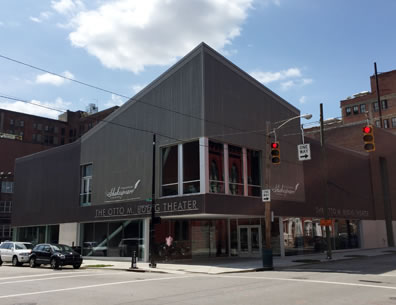
Cincinnati Shakespeare Company's Otto M. Budig Theater. Photo by Eric Minton.
Speaking of accommodations, not only are all the public areas ADA accessible, including flexible seating options, the catwalks meet Americans with Disabilities Act Guidelines. A sense of artistic accessibility also guided the building's design. A rehearsal room on the second floor has large bay windows, giving actors views of Washington Park across the way and people in Washington Park views of the actors rehearsing. The room can also serve as a space for cocktail parties and dinners, a meeting room (a projection system is built in to the design), and a studio theater. At the end of the hallway upstairs is a window with a view of the back stage. In addition to an on-site rehearsal space, the theater houses dressing rooms, costume shop, prop shop, a set-building shop, and administrative offices in a former union headquarters conjoined with the back of the new theater structure.
The auditorium is intimate (no seat, including the second tier, is more than 20 feet from the stage) and the sightlines are generally good. A lighting rig obstructs the view for the single row of 45 seats in the second tier, requiring patrons to lean forward to see the entire stage. However, the thrust stage is wide (as Chace's Snug attests), deep, and tall enough to handle a three-story set at the back of the stage. The theater also has flying capabilities, which get quite a workout in A Midsummer Night's Dream, and the acoustics are incredible. For A Midsummer Night's Dream, microphones are used only for occasional special vocal effects by the fairies, yet an under-the-breath comment high on that set at the back of the stage is perfectly audible in the third row. Not as dramatic but logically useful are the cup holders for each seat, as in a sports arena.
For all the design principles that went into its construction, the overriding guiding principle in the building of the Otto M. Budig Theater is as a place to enjoy Shakespeare.
Eric Minton
September 15, 2017
Comment: e-mail editorial@shakespeareances.com
Start a discussion in the Bardroom



 Find additional Shakespeareances
Find additional Shakespeareances